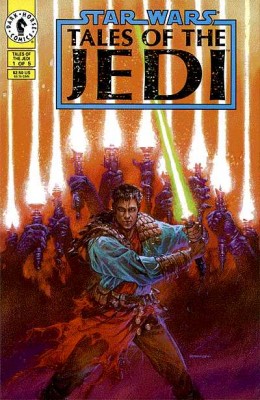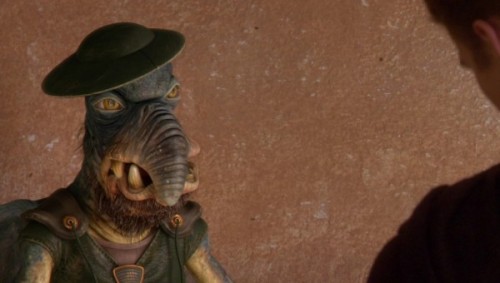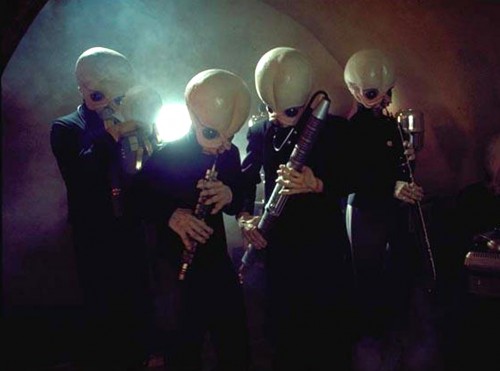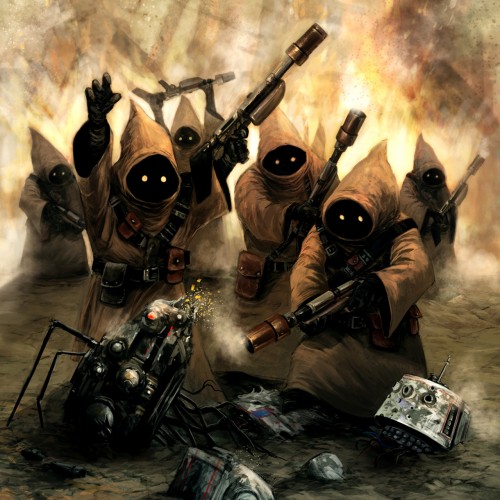Several years ago there was a funny post about Star Wars making the rounds on the internet. The original source seems to have disappeared long ago and it now only exists preserved by other people who felt the need to share it with other. (I once read a report that a study found that on average, any content on the internet has a 7% chance per year to disappear.) Being the big but also critical Star Wars fan that I am, I want to also do my part in keeping this pamphlet of historic significants preserved for future generations.
With the new movies (or “Nu Wars”) being approaching swiftly and some people saying that the Extended Universe is gone, this feels like an appropriate time to share this wonderful manifesto of true Star Wars fans.
By: Adam Summers 5/23/05
My girlfriend doesn’t understand what I see in Star Wars. We’ve had several soul-crushing arguments about what exactly makes this series so important to me, and every time I have found it more and more difficult to argue my case. As the maddening years have wound on, I think I finally understand the reason for this crippling handicap.
There is a diabolical twist to Star Wars fandom, you see, that defies comprehension, and yet is the life-blood of all Star Wars fans. It is this:
Star Wars fans hate Star Wars.
If you run into somebody who tells you they thought the franchise was quite enjoyable, and they very-much liked the originals as well as the prequels, and even own everything on DVD, and a few of the books, these imposters are not Star Wars Fans.
Star Wars fans hate Star Wars.
The primary fulcrum for the Star Wars fan’s hate (including my own) is George Lucas, creator of Star Wars. Unlike Trekkies/Trekkers who adore Star Trek creator Gene Roddenberry, Star Wars fans hate the father of their obsession. We hate the fact that George Lucas got it wrong from the beginning, creating incest between Luke and Leia. We hate the fact that he wrenched Return of the Jedi off of Kashyyyk and set it on Endor with those tiny, furry Hobbit bitches he called “Ewoks”, which is a syllabic anagram of Wookiee if you’re obsessed enough. We despise the entire existence of literally half of the Star Wars movies, blaming George Lucas’ greed and flawed ‘vision’ for everything.
We believe George Lucas’ ideal death time was 2:07am, 14 November, 1990.
Star Wars fans also hate the original Star Wars trilogy. We think Mark Hamill’s acting was whiny, the pacing was flawed, and Empire was better than Jedi, making the end of the series a let-down. We hate the way Boba Fett died, and we hate the cantankerous, arthritic duel between Vader and Obi-wan. We don’t understand why the storm-troopers can’t shoot worth a damn, and we don’t get why “an entire legion of [the Emperor’s] best troops”(ROTJ, Palpatine) can be overpowered by a tribal society of midget teddy-bears armed largely with rocks and twigs. Star Wars fans hate omnipotent war-machines that get their legs tangled in strings, or slip on logs. They hate Darth Vader’s face and that stupid harmonica thing he was playing. Star Wars fans hate the original Star Wars trilogy.
There is also, as you probably know, a series of Special Editions that have replaced the original Star Wars trilogy, and these are also hated by Star Wars fans with an even more scorching fervor. Star Wars fans hate the glaring CG changes made to scenes we already hated to begin with. We hate that Han Solo now killed Greedo in self-defense, and then stepped on Jabba the Hutt’s tail (which we liken to Carrot Top stepping on Fidel Castro’s tail). We hate the fact that the ghost of Alec Guinness (whose name is an anagram of Genuine Class, by the way) now stands next to Hayden Christensen (whose name I tried to re-arrange into a flattering anagram myself, but only came up with “Nn…Dense Chest Hair”). Star Wars fans are unsure if Fidel Castro has a tail or not, but we hate the Special Editions of the trilogy just the same.
There is of course also a prequel trilogy to Star Wars. It is newer, more epic, more expensive, and more visually stunning than the original trilogy. Star Wars fans know this, and so we hate it even more. We hate it with the burning passion of a setting pair of twin suns. Jar Jar Binks, Midichlorians, technology that is blatantly more sophisticated than the “later” original trilogy…we despise all of it. There’s nothing a Star Wars fan hates more than a Star Wars prequel. They demystified Boba Fett, contradicted countless lines in the original trilogy (Obi-Wan: “He was our only hope.” Yoda: “No…there is another.” Obi-Wan (not in script): “Oh, right, I f*cking held both of these kids as they were born in Episode 3. Sorry Yoda, I just plumb forgot!”)
Star Wars fans think Mark Ha…uh…Hayden Christensen’s acting was whiny. And the pacing was flawed.
Beyond the movies, there are also various television-related Star Wars endeavors which Star Wars fans despise. Starting with that abysmal “Holiday Special” in which Carrie Fisher appeared drunk and tried to celebrate Christmas through song in a Jesus-less galaxy, Star Wars fans have watched and hated everything. We think Droids was a waste of time, Ewok Adventures was an extension of everything we hated about Return of the Jedi, and we’ve seen both seasons of Clone Wars which we hate because we believe them to be immensely inconsistent with the prequels we also hate.
Star Wars fans think the Star Wars comic-books are a stockpile of contrivance written for marketing purposes by people who know nothing about Star Wars. Every gimmick imaginable to bring back super-weapons long destroyed and token bad-guys long-beaten is spewed forth from these comic books, and Star Wars fans want nothing to do with it. Star Wars fans have read the one in which Han Solo works in tandem with a giant rabbit and we are not impressed.
Then, naturally, there are the videogames. Star Wars fans hate LucasArts, and the opportunist drivel that comprises most of the gameplay-less apertures known as Star Wars games that they vomit up every fiscal quarter. Star Wars fans know that there is no such thing as a good Star Wars strategy game, we yelled at our PS1 when Masters of Teras-Kasi came out, and we kind-of liked the Jedi Knight series, but not at first and definitely not towards the end. Star Wars fans did not like Knights of the Old Republic, unless they were RPG fans. This does not count. Star Wars fans hate Star Wars videogames.
The final main elixir of Star Wars folklore is the ever-growing library of Star Wars books. These have managed to make a complex main character our of practically every background alien seen in the movies, and expanded the universe into a colossal, self-contradictory maze. Star Wars fans hate this. We hate how trite and tired the books were getting before the New Jedi Order series, and we hate the New Jedi Order series for being so radically different, and not nearly trite or tired enough. Star Wars fans hate it when previously-deceased characters are brought back to life, but we also hate Timothy Zahn for not bringing his characters back to life. Star Wars fans did not hate Grand Admiral Thrawn, but we do now, because he is always dead. The Star Wars movies also contradict and completely ignore droves of information within the Star Wars books. Star Wars fans now know that George Lucas has no idea who Jaster Mareel is, and it makes us very angry. Star Wars fans hate Star Wars books.
Now that I have covered all of this, you can finally begin to compute why I can never prove to Emily that Star Wars is a monumental event worth devoting one’s life to. The very nature of the argument means I have to defend Star Wars, and since I am a Star Wars fan, I don’t actually understand how to do that.
Maybe I’ll put it like this. To be a Star Wars fan, one must possess the ability to see a million different failures and downfalls, and then somehow assemble them into a greater picture of perfection. Every true Star Wars fan is a Luke Skywalker, looking at his twisted, evil father, and somehow seeing good.
My earlier statement needs slight revision. We hate everything about Star Wars.
But the idea of Star Wars…the idea we love.

 Star Wars: Tales of the Jedi is a comic series that was published by Dark Horse from 1993 to 1998 with a total of 35 issues. This was only two years after the Thrawn Series by Timothy Zahn had kickstarted the Expanded Universe as we know it now, placing it pretty early in the history of Star Wars tales. The series was created by Tom Veitch, who had written the Dark Empire comic series a year earlier (which I consider the greatest travisty of the Star Wars universe after the Holiday Special), but he was joined by Kevin Anderson in 1994, who had just released his Jedi Academy novel series (which also has a pretty poor reputation among fans) and became the sole writer for the series a year later.
Star Wars: Tales of the Jedi is a comic series that was published by Dark Horse from 1993 to 1998 with a total of 35 issues. This was only two years after the Thrawn Series by Timothy Zahn had kickstarted the Expanded Universe as we know it now, placing it pretty early in the history of Star Wars tales. The series was created by Tom Veitch, who had written the Dark Empire comic series a year earlier (which I consider the greatest travisty of the Star Wars universe after the Holiday Special), but he was joined by Kevin Anderson in 1994, who had just released his Jedi Academy novel series (which also has a pretty poor reputation among fans) and became the sole writer for the series a year later.

